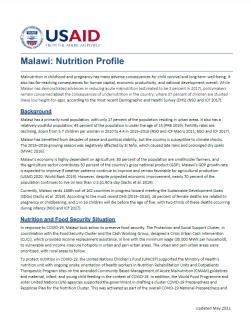Malawi has a primarily rural population, with only 17 percent of the population residing in urban areas. It also has a relatively youthful population; 45 percent of the population is under the age of 15 (PRB 2019). Fertility rates are declining, down from 5.7 children per woman in 2010 to 4.4 in 2015–2016 (NSO and ICF Macro 2011; NSO and ICF 2017).
Malawi has benefited from decades of peace and political stability, but the country is susceptible to climate shocks. The 2015–2016 growing season was negatively affected by El Niño, which caused late rains and prolonged dry spells (MVAC 2016).
Malawi’s economy is highly dependent on agriculture; 80 percent of the population are smallholder farmers, and the agriculture sector contributes 30 percent of the country’s gross national product (GDP). Malawi’s GDP growth rate is expected to improve if weather patterns continue to improve and remain favorable for agricultural production (USAID 2020; World Bank 2019). However, despite projected economic improvement, nearly 70 percent of the population continues to live on less than U.S.$1.90 a day (Sachs et al. 2019).
Currently, Malawi ranks 146th out of 162 countries in progress toward meeting the Sustainable Development Goals (SDGs) (Sachs et al. 2019). According to the most recent DHS (2015–2016), 16 percent of female deaths are related to pregnancy or childbearing, and 1 in 16 children will die before the age of five, with two-thirds of these deaths occurring during infancy (NSO and ICF 2017).

